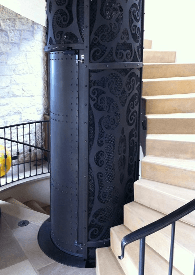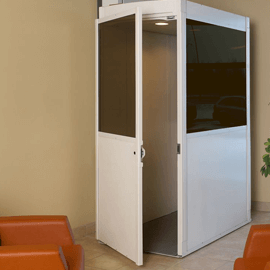Home Elevator Maintenance Service
 The cost of an in-home elevator doesn’t stop after installation: Just like owning a car or a computer, parts can break, and repairs may need to be made. This is why it is so important to understand the expected elevator maintenance schedules. Let’s take a look at the expected maintenance for your average residential elevator.
The cost of an in-home elevator doesn’t stop after installation: Just like owning a car or a computer, parts can break, and repairs may need to be made. This is why it is so important to understand the expected elevator maintenance schedules. Let’s take a look at the expected maintenance for your average residential elevator.
What Is Elevator Maintenance?
Elevators are complex machines with many moving parts, and home elevator maintenance is a necessary practice in which a professional makes sure all parts and machinery are in working order to ensure elevator safety.
Getting Annual Inspections From a Home Elevator Maintenance Service
Many states now require that homeowners have their in-home elevators inspected annually by a home elevator maintenance service. Even if your state does not require this, it is still a good habit to have your elevator inspected on a yearly basis. Why? The standard residential elevator has a lot of moving parts; if you only inspect your elevator when there’s an issue, your elevator may not last as long as it should. Inspect it regularly to keep your elevator running smoothly and to help avoid breakdowns.
How Much Does Lift Maintenance and Elevator Repair Cost?
The typical residential elevator maintenance cost differs from the cost of commercial elevator maintenance, and the price of fixing up an elevator is also dependent on the specific type of lift and the type of work needed. How much does lift maintenance cost? Repair costs will be calculated by hours of labor in addition to any parts needed.
What to Expect During an Elevator Inspection
Elevator inspection rules and guidelines vary from state to state, but there are some basic guidelines that most states will follow. It should also be noted that the cost of an elevator inspection will vary from state to state, and the cost of a commercial inspection may be different than the cost of a residential elevator inspection.
Here are some examples of what an elevator inspection will likely consist of:
- If there is an elevator machine room, check to see if there is a wall-mounted fire extinguisher in place.
- Check to make sure the machine room has a self-locking lockset.
- Make sure there is a code-compliant way to access the machine room.
- Make sure a separate branch circuit has been installed for lighting in the machine room.
- Check for a fused disconnect or circuit breaker to disconnect all ungrounded conductors for the elevator./li>
- Check for smoke detectors.
- In the elevator cab, make sure there is finished flooring.
- All flooring material must be installed so that there is no tripping hazard to occupants.
- Make sure there is permanent hall lighting at each elevator landing entrance.
- Entrance sills must be grouted or otherwise provided with the means to support any loads imposed.
- Make sure a hoistway key-operated vent switch has been installed. This key-operated vent switch must be removable in the closed position and located adjacent to a fire control panel or in the elevator lobby of the designated floor.
- Check for an elevator corridor call station pictograph at each corridor call station.
- Lobby initiating devices should be mounted on the ceiling within 21 feet of any elevator landing or entrance area.
Maintain Cables, Pulleys, and Fluids in Driveshaft Elevators
In traditional driveshaft elevators, parts can wear out rather quickly, and it is not uncommon for homeowners to annually replace cables, pulleys, and fluids to keep their elevators working smoothly. If you choose to avoid yearly maintenance and inspections, you could end up paying even more in repairs. If finances will not allow you to handle yearly maintenance, then maybe you should look into a home elevator that does not require as much maintenance.
The Low-Maintenance Elevator: Vision 450
The Vision 450 is a low-maintenance elevator that we sell at Nationwide Lifts. The Vision 450 requires no pit, no machine room, and no pulleys, ropes, chains, or counterweights. Since there are fewer moving parts, this elevator requires far less maintenance than the traditional styles and also has fewer breakdowns. This elevator will cost more up front, but at least you don’t have to worry about yearly part replacements. If you’re looking for a lift with the least elevator maintenance, the Vision 450 is the elevator for you.
How Often Does a Vacuum Elevator Require Maintenance?

One manufacturer reports that vacuum elevators require maintenance only once every five years to replace the main seal, or every 15,000 lifts, compared to once a year for a traditional home elevator. Vacuum elevators, which operate by manipulating air pressure in a vacuum tube, require few moving parts and no pit excavation or machine room, so they are easy to install and require less maintenance. The cost of maintenance can quickly eclipse the original installation cost for a traditional elevator, but vacuum elevators enable you to save hundreds on maintenance costs.
Vacuum elevators are sleek tubes that use the clear polycarbonate tube as a shaft, providing passengers with a clear view of the home as they travel. Operation is very simple: The elevator creates a vacuum at the top of the tube, and air pressure moves the cab up. Descent is even easier, using gravity and controlled air flow, allowing the cab to descend slowly and safely without using any energy.
Vacuum elevators contain three main parts: the hoistway cylinder, the vacuum elevator car, and the suction assembly.
The cylinder is the tube made of sheets of polycarbonate in modular lengths that fit together easily. The doors are made of the same material, are airtight, and are provided with magnetic safety locks. The roof of the tube is made of steel to ensure a tight core with suction valves and air inlets.
The vacuum elevator car is made of transparent polycarbonate and mounted on a steel frame. There is an air joint on the cab roof that ensures normal air pressure and air conditions for the passengers and an anchoring system that activates when reaching the desired floor to ensure an exact stop.
The suction assembly can be built on the same tube that holds the cab or separately at distances up to 30 feet from the cylinder. It holds a monophase motor.
When planning for elevator maintenance, look for providers that offer maintenance plans that provide routine inspections, lubrication, and the replacement of minor and major parts. With a vacuum elevator, you can request a limited maintenance plan that doesn’t require regular service.
<< Back to Articles
